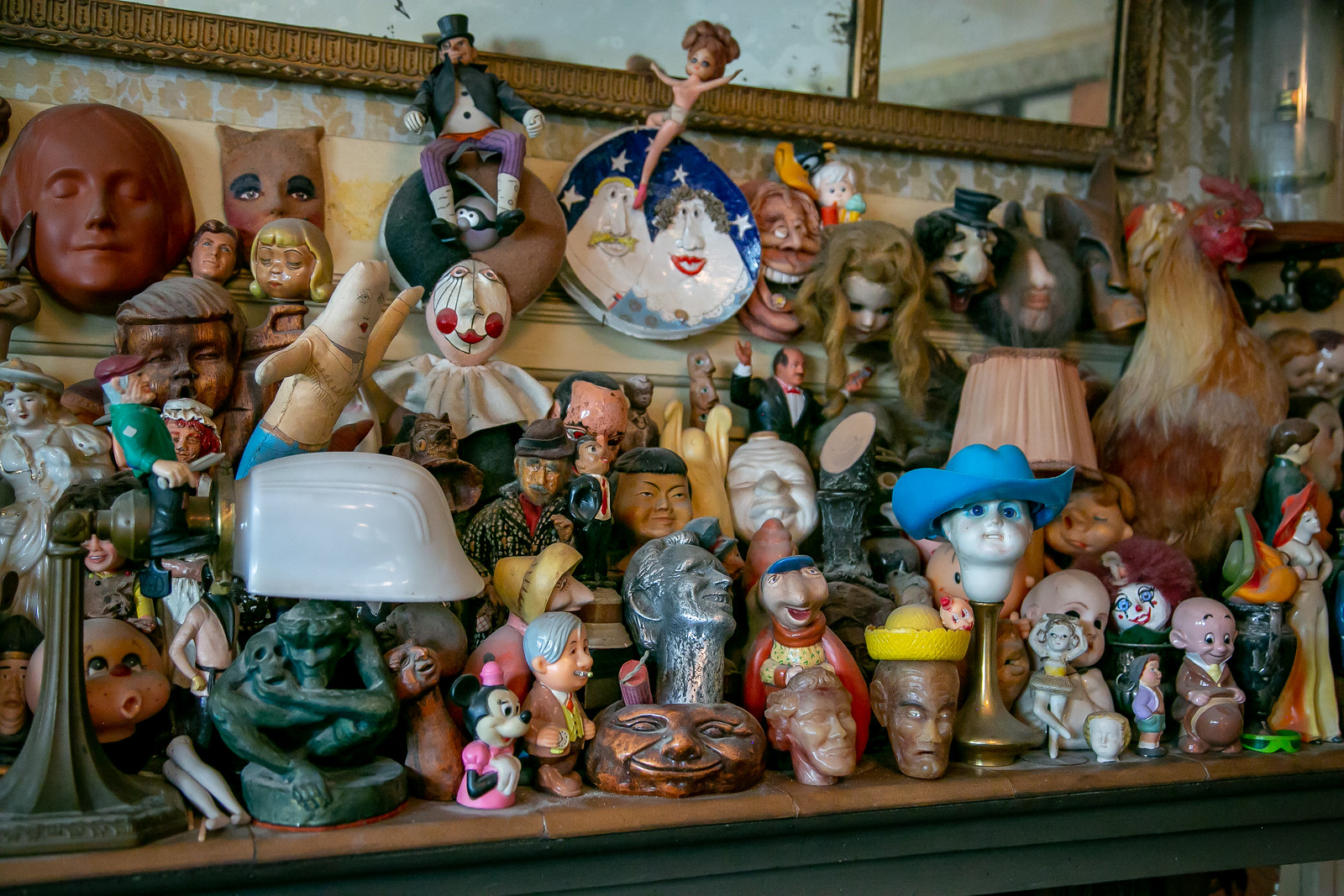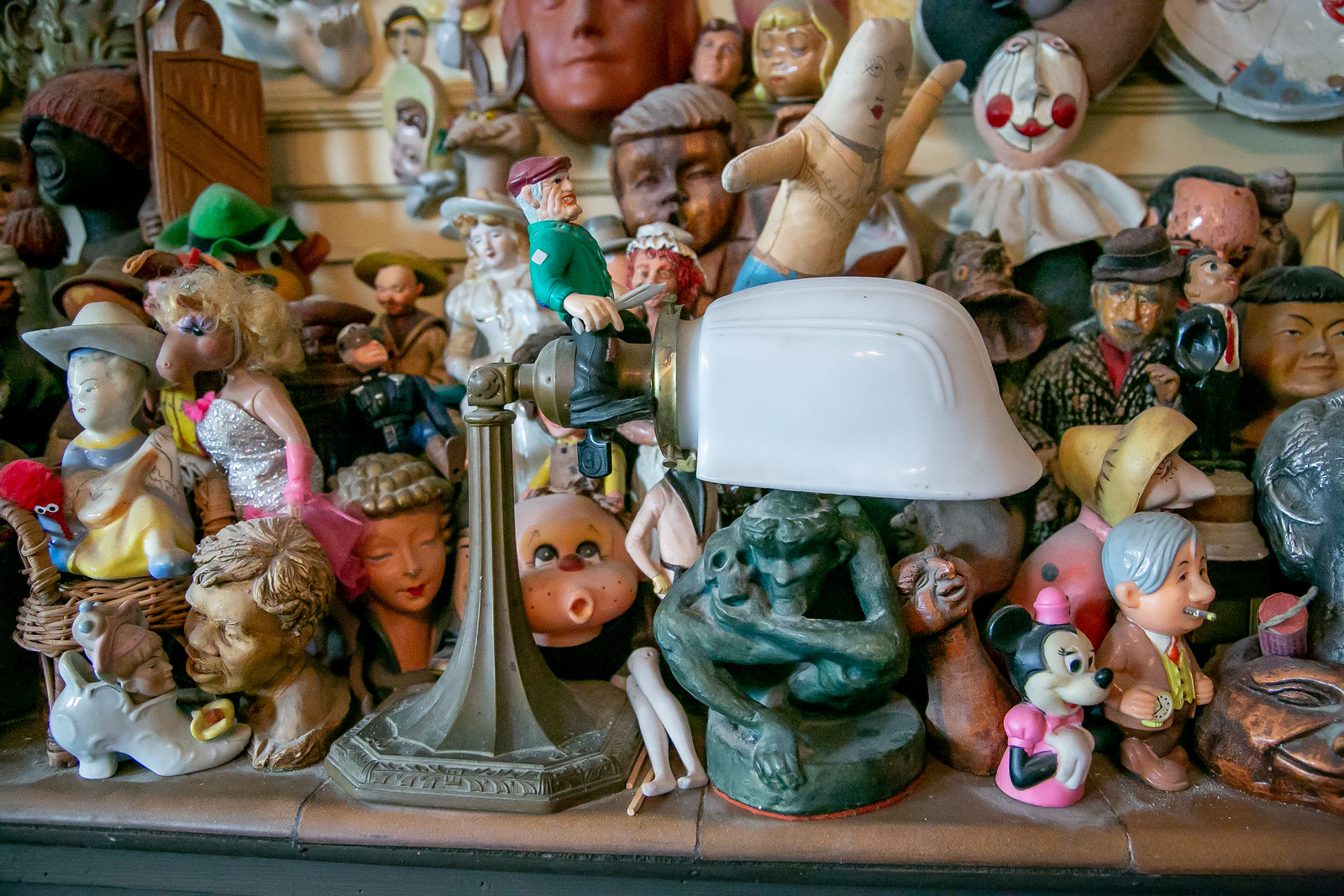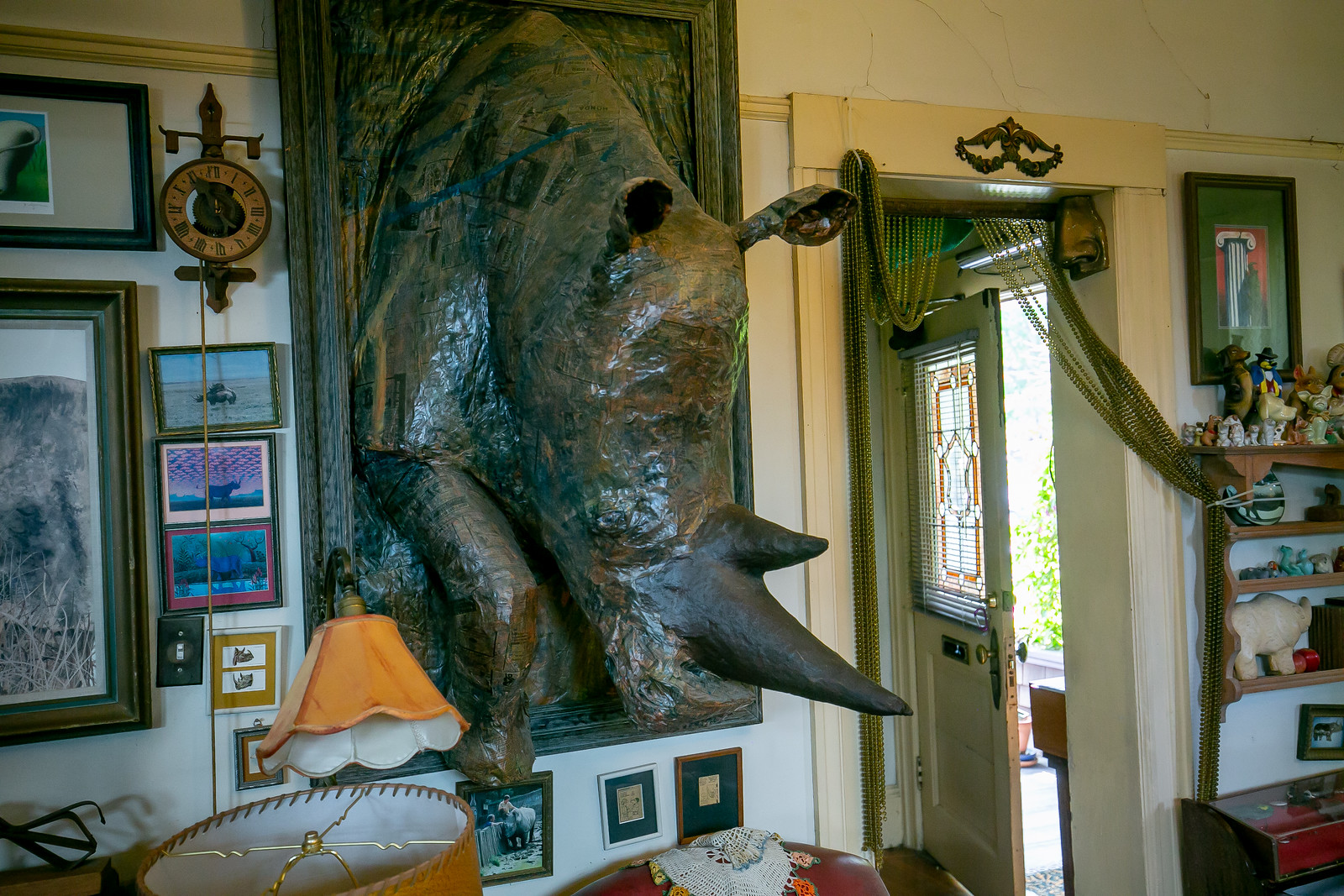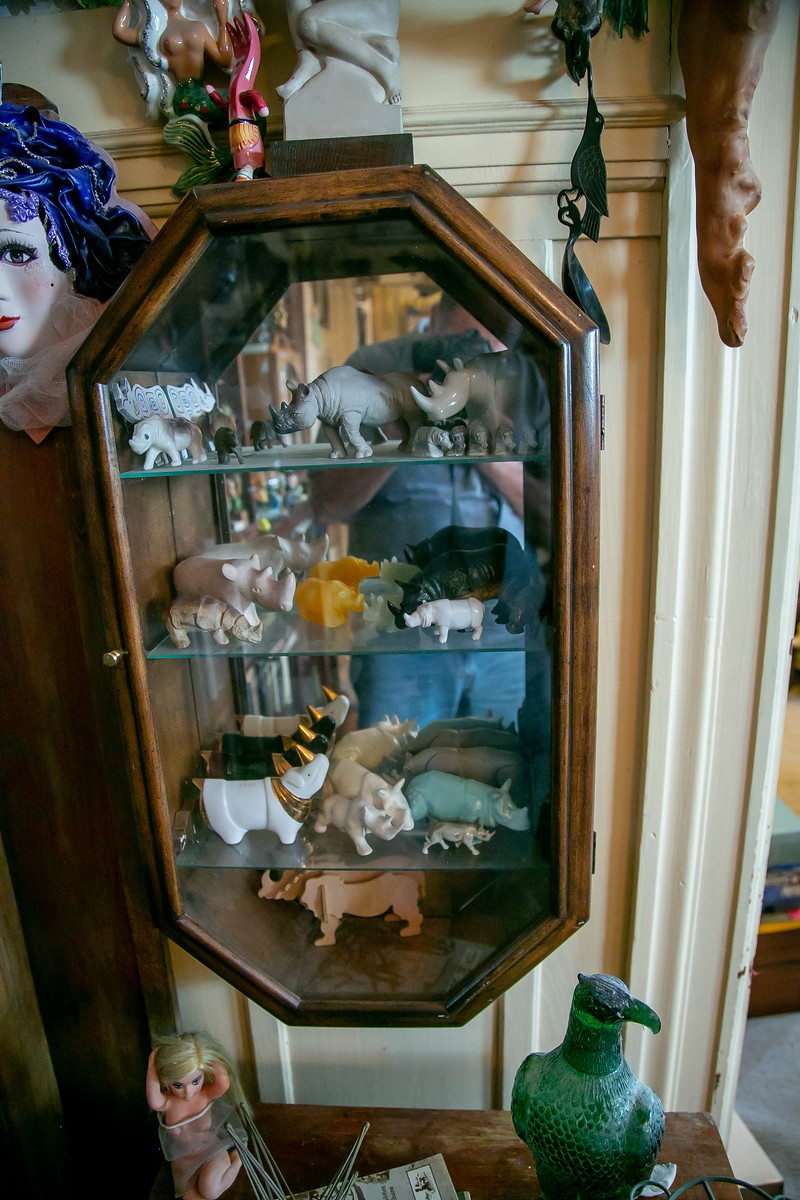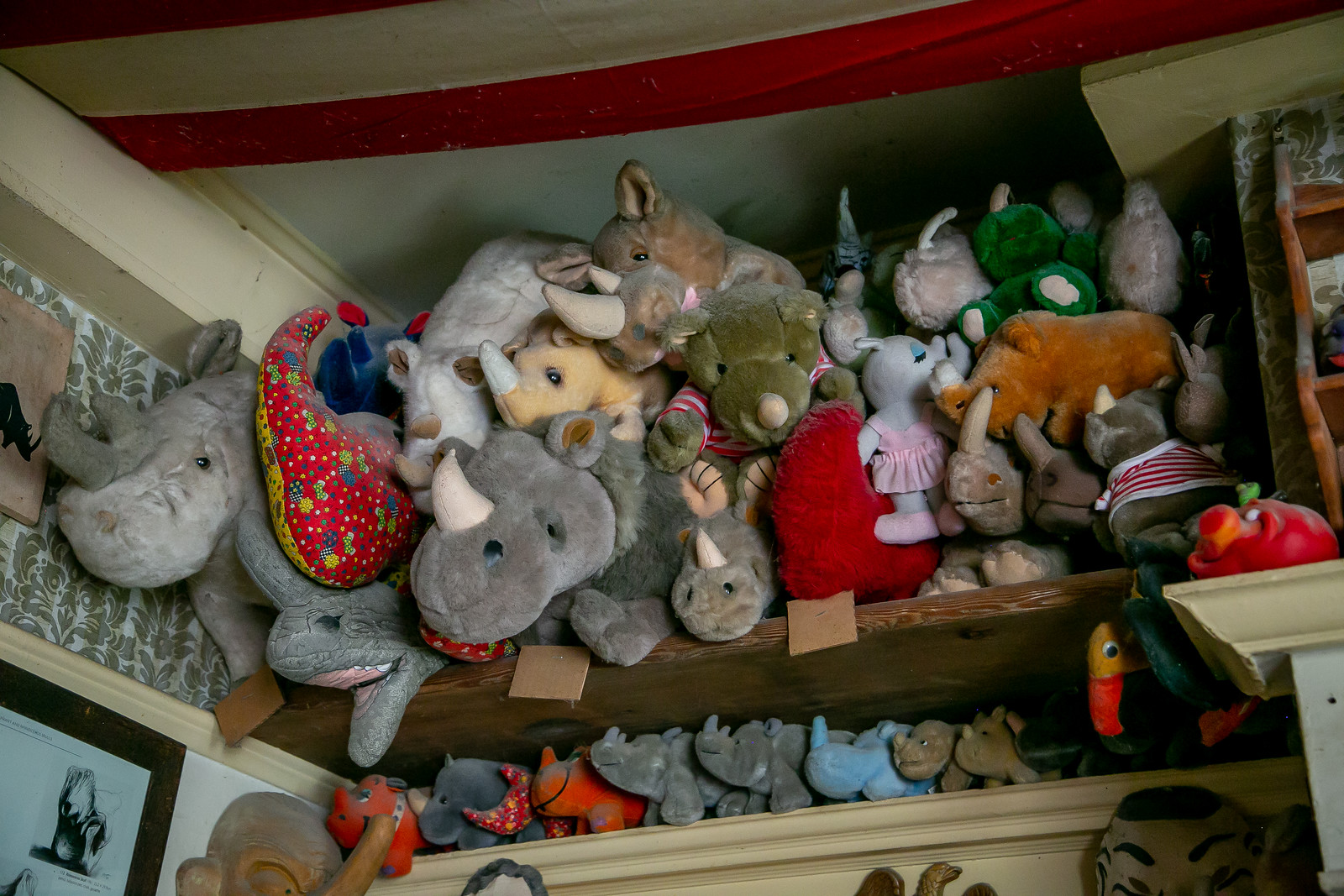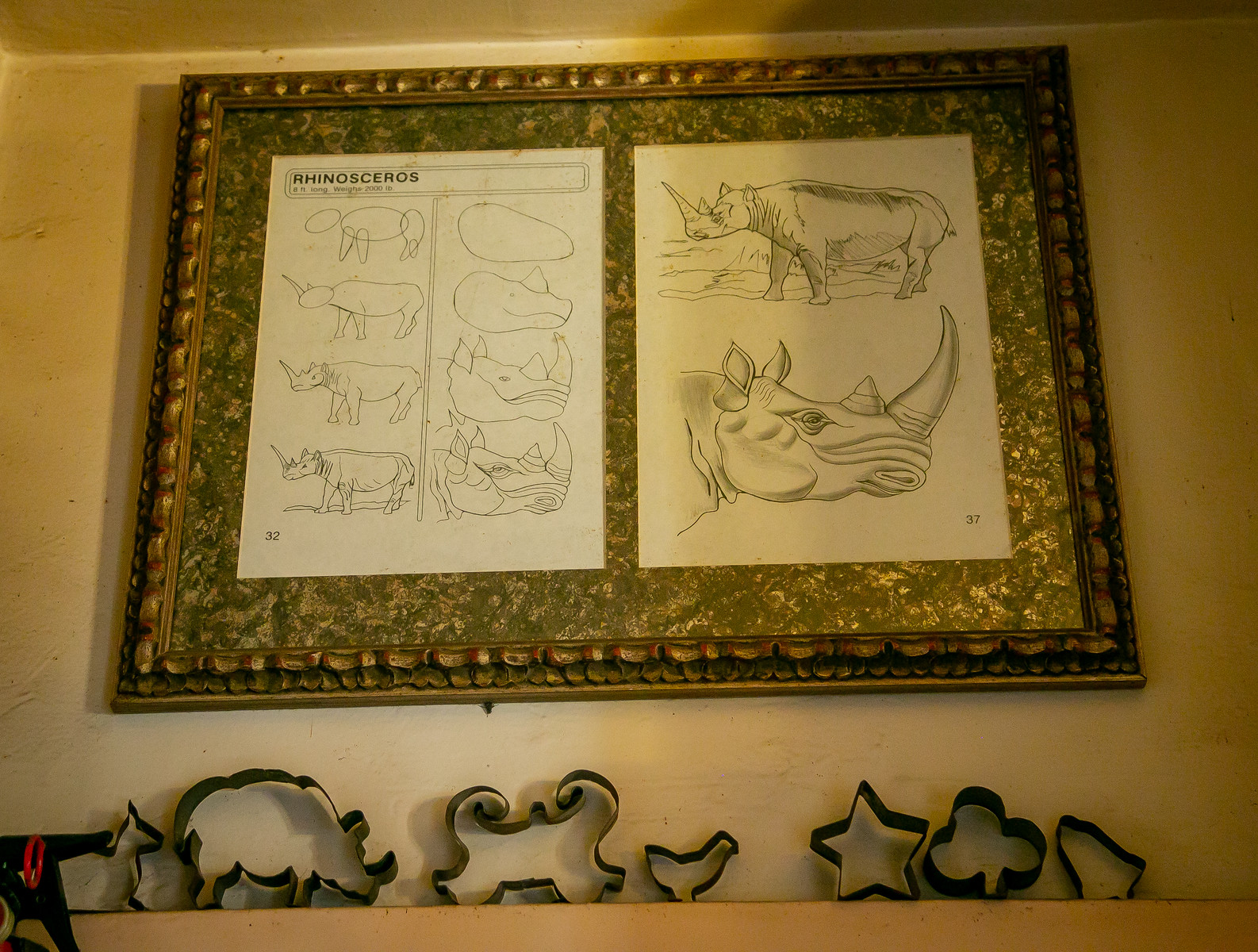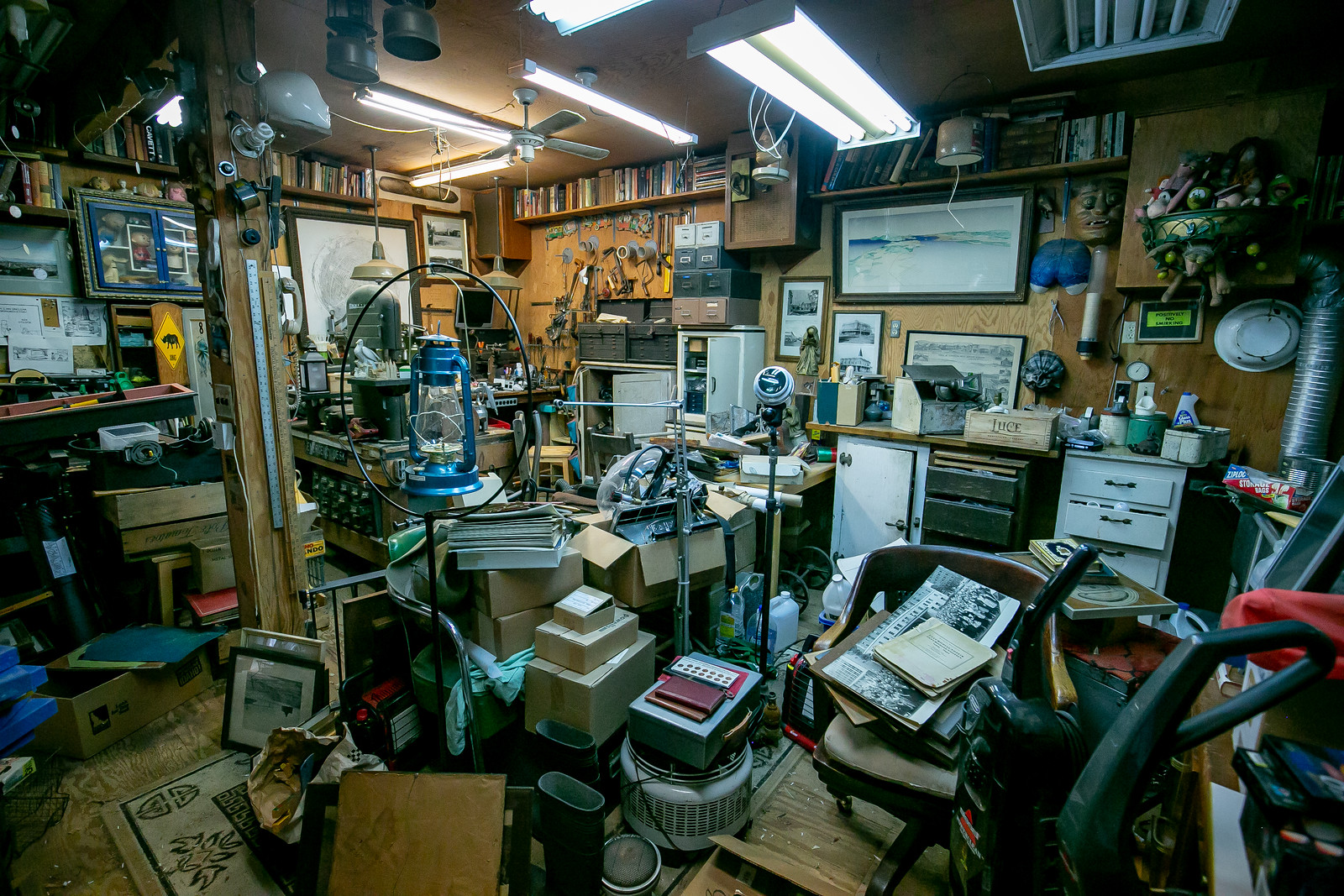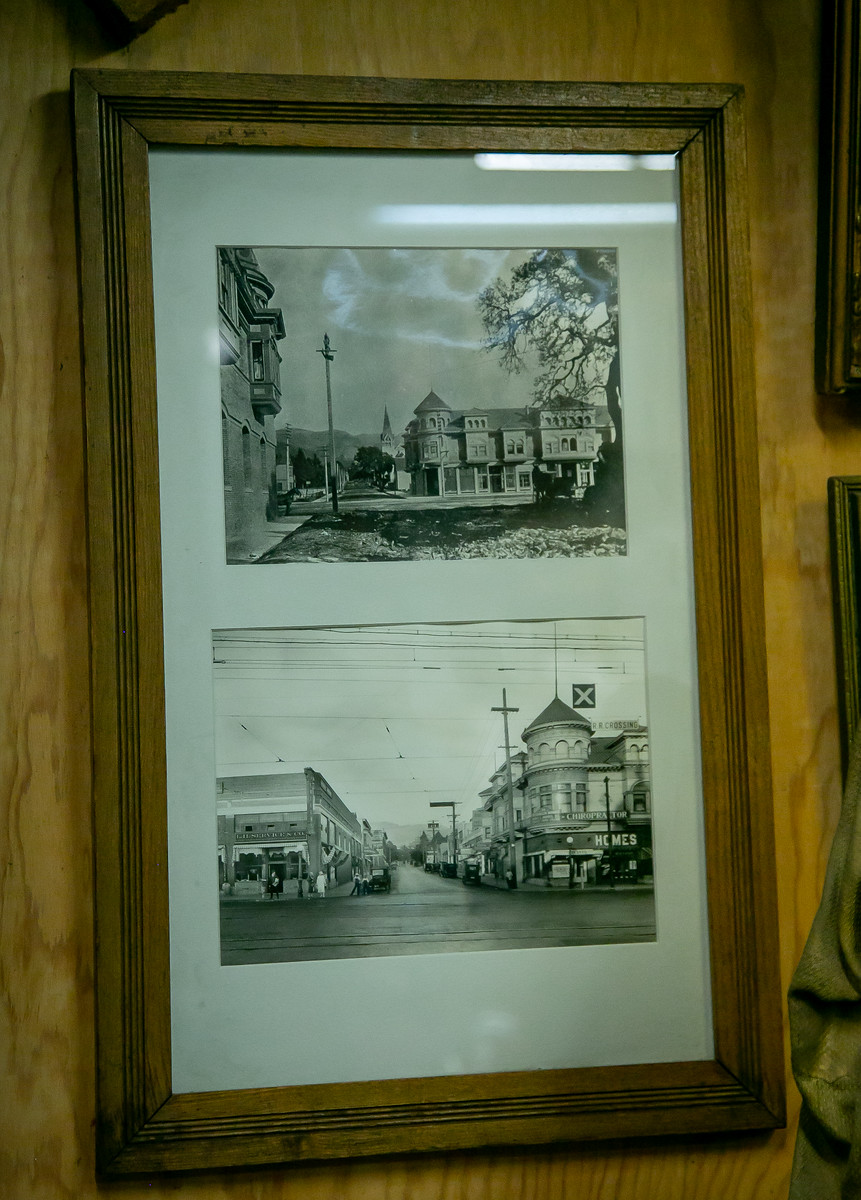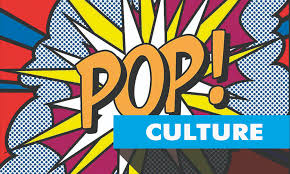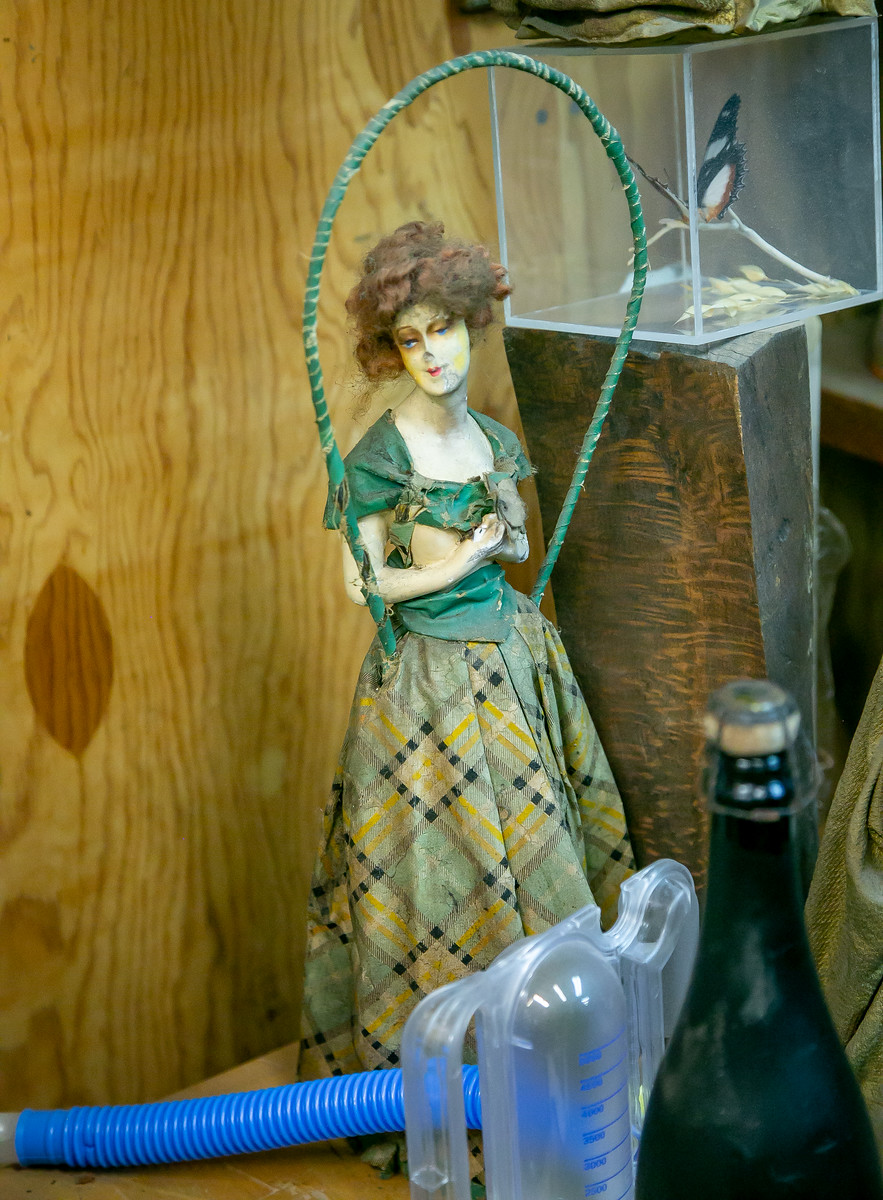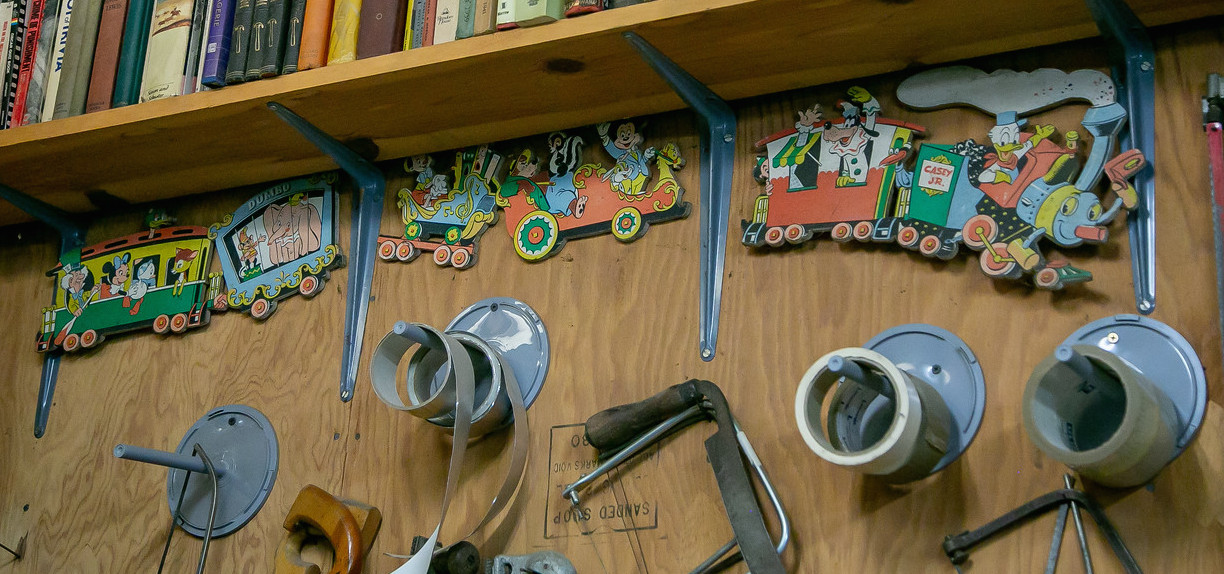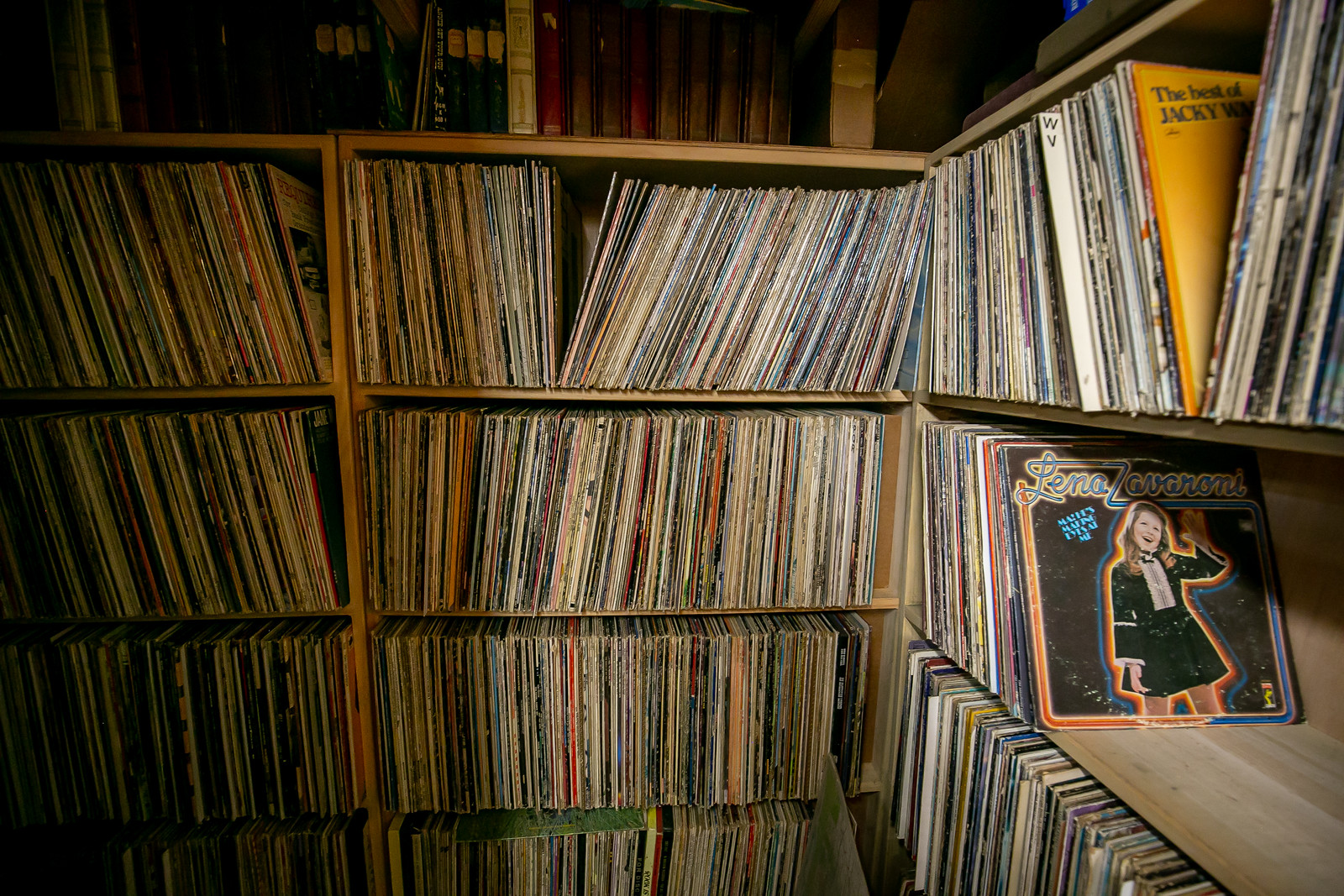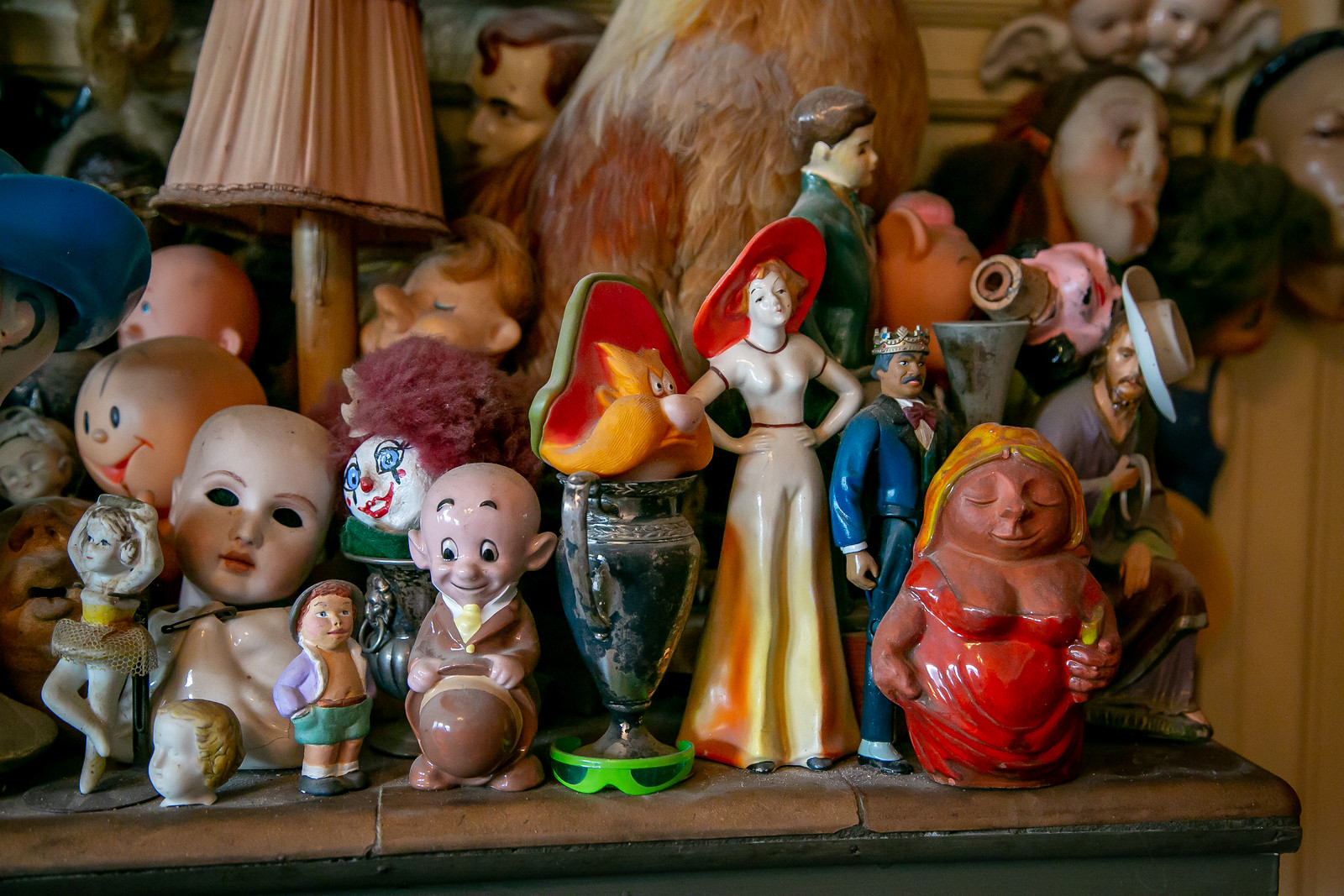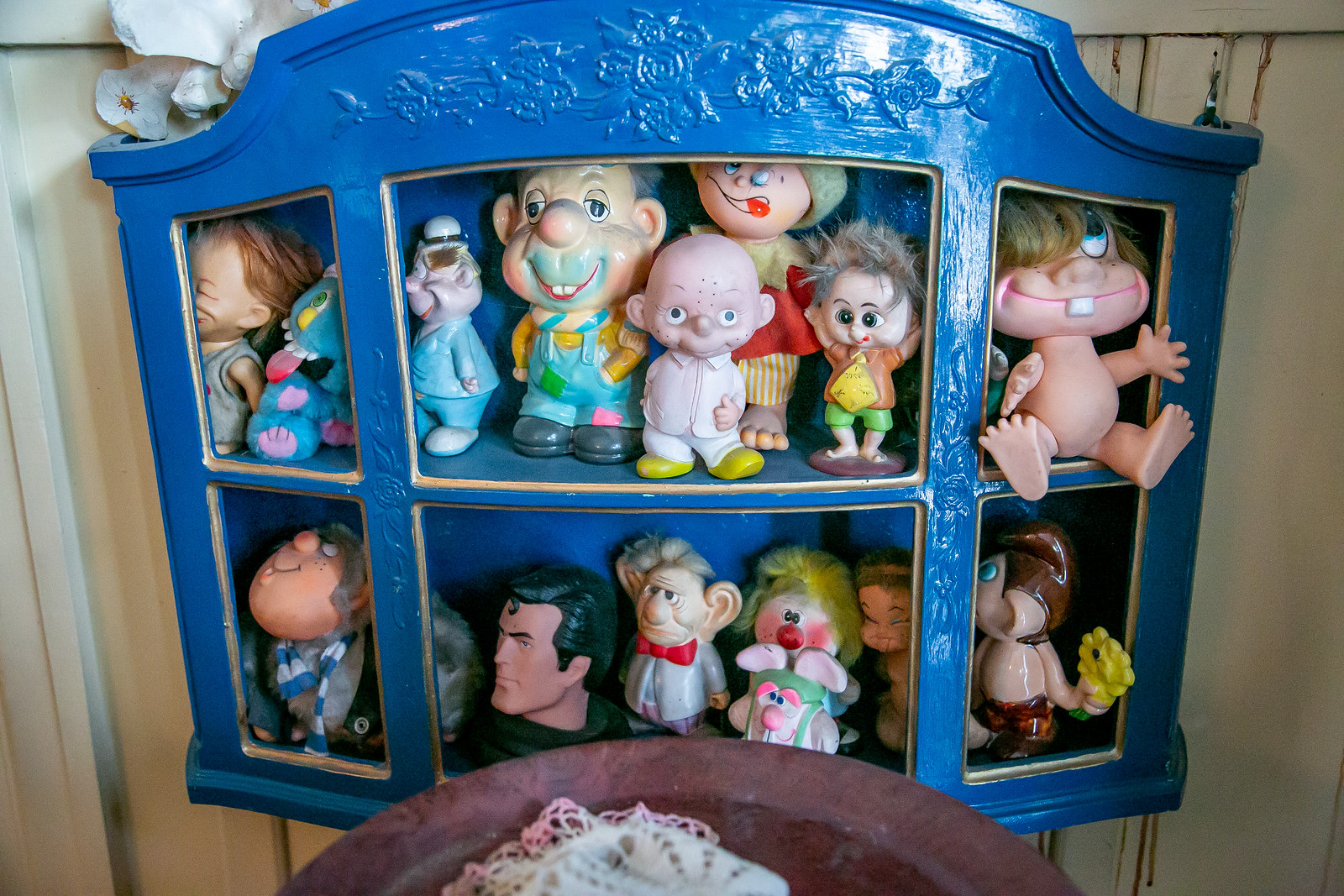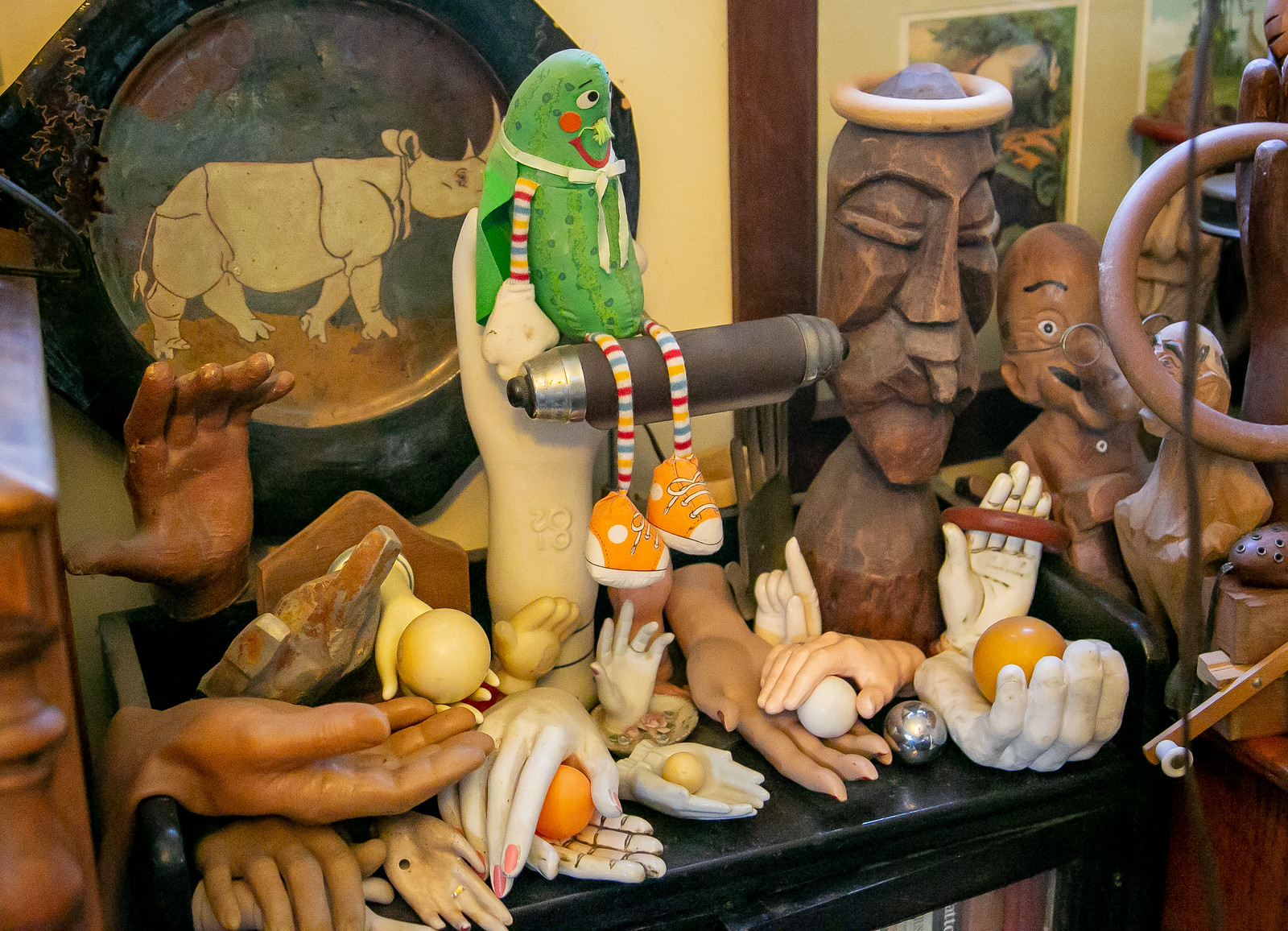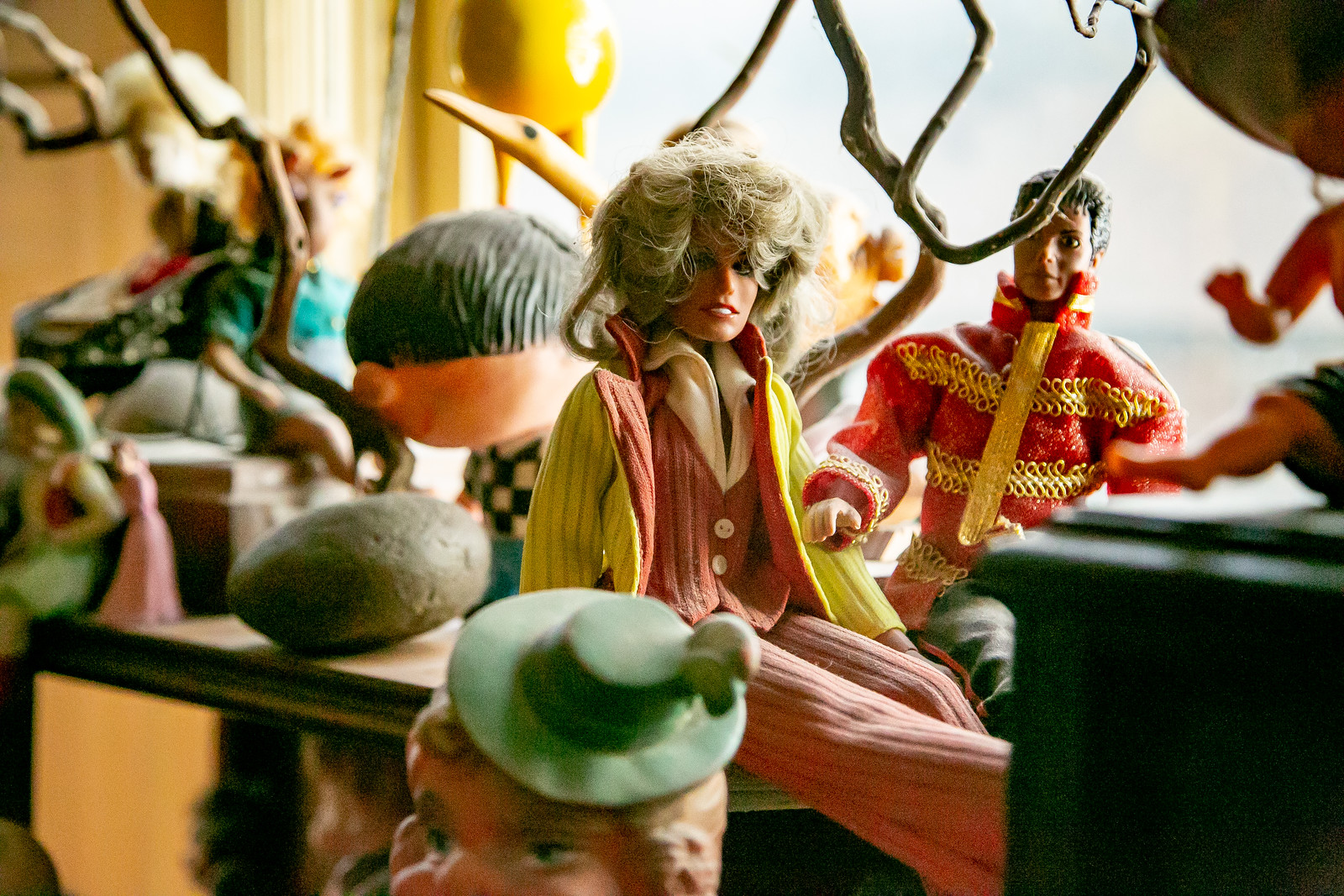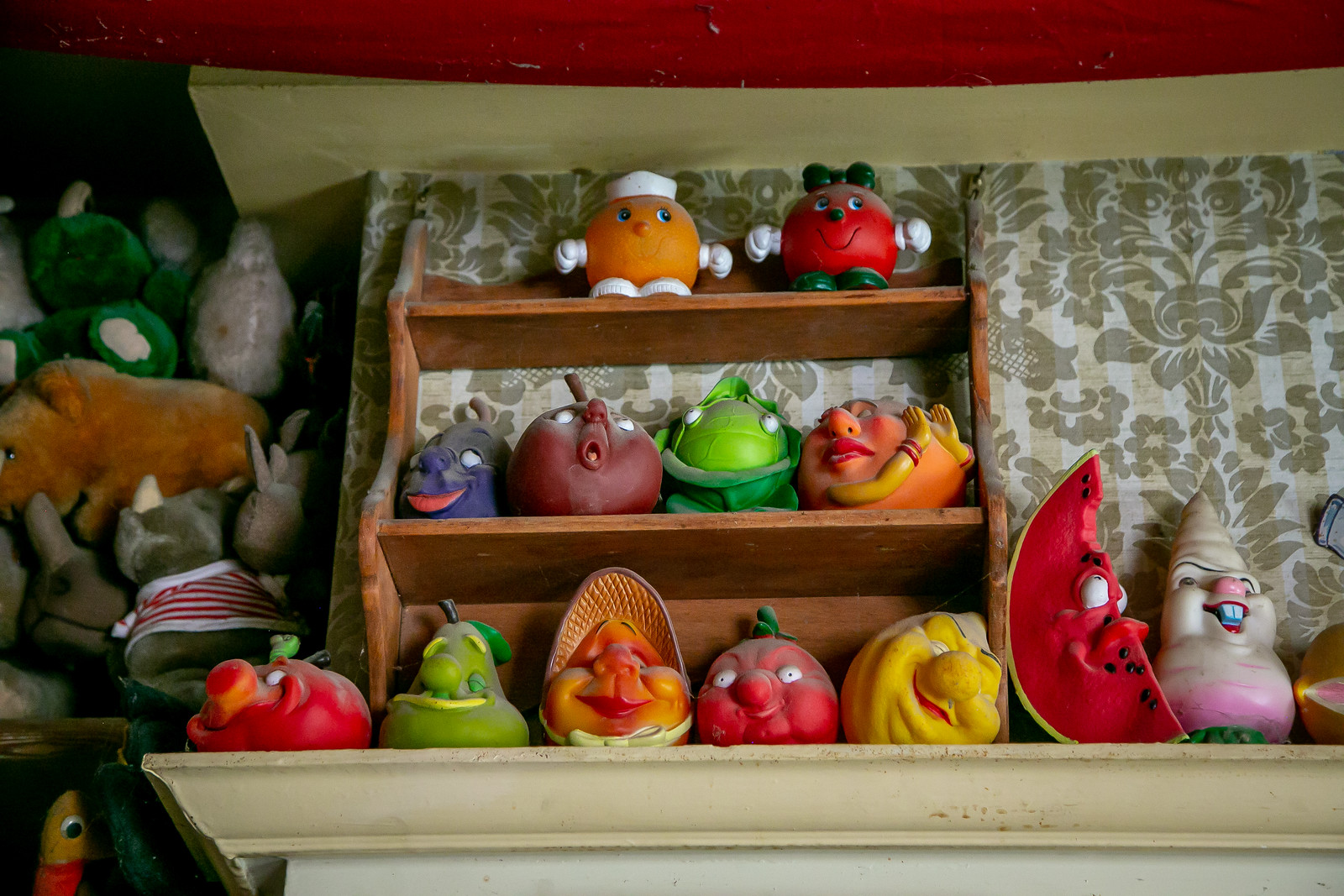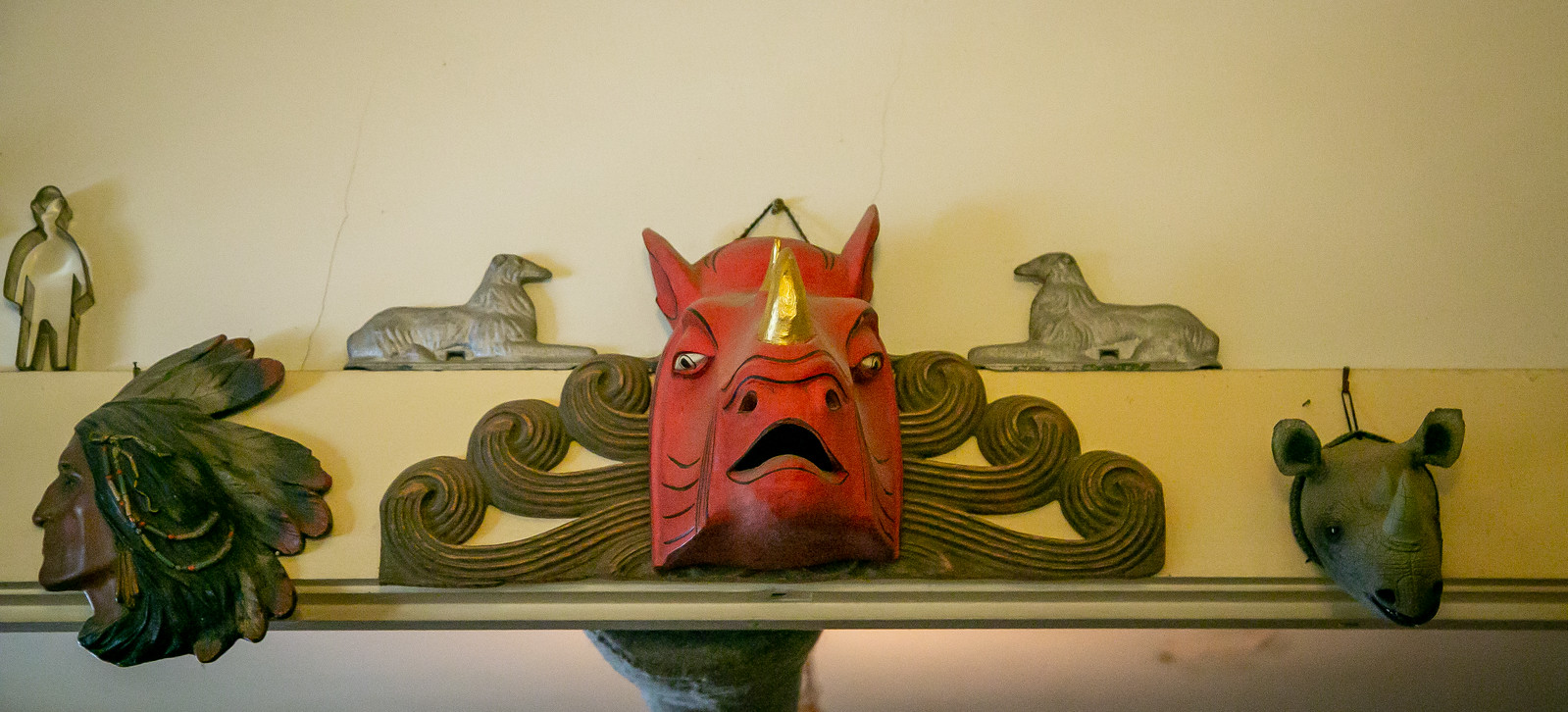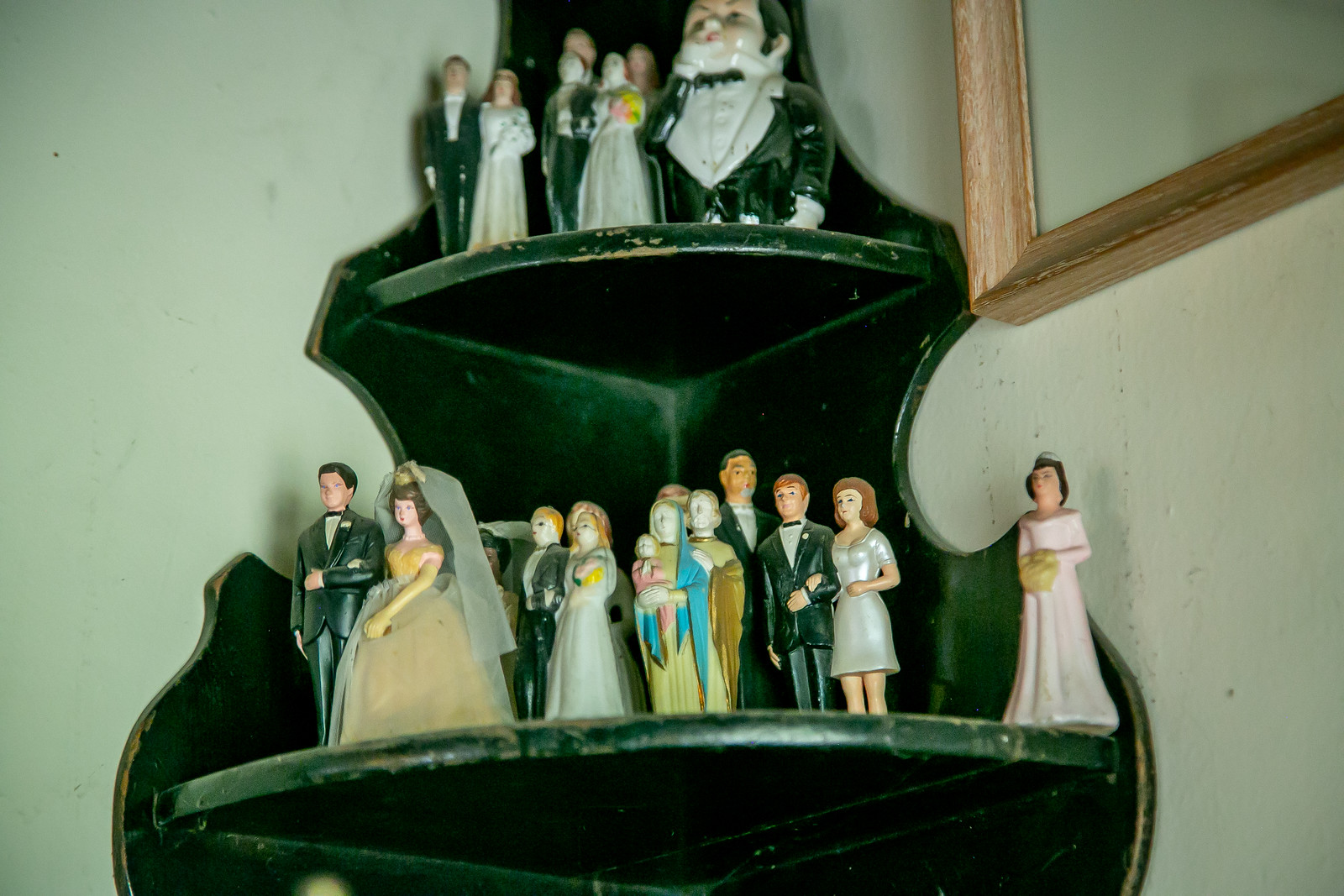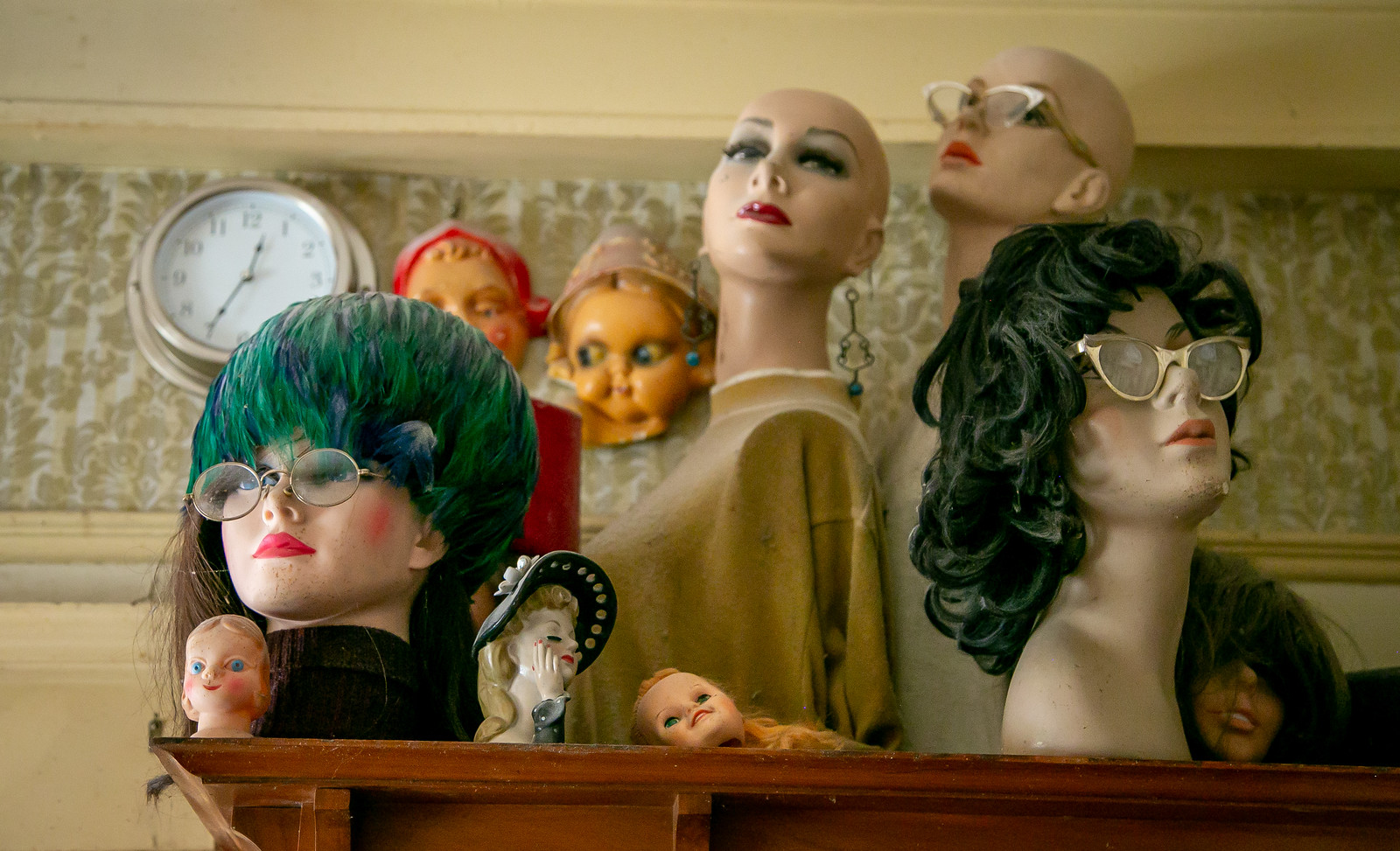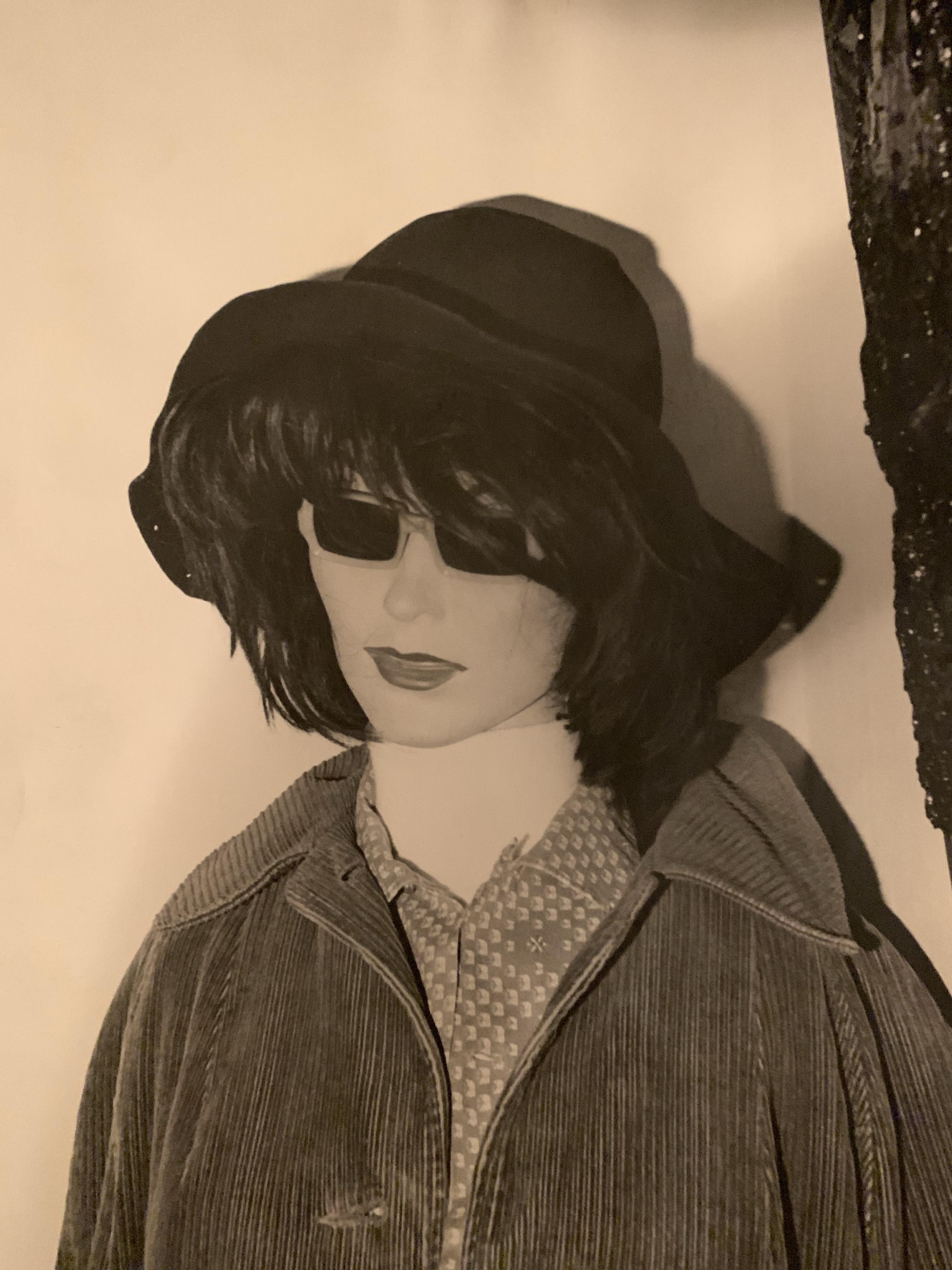I have rarely been overcome by a quirky scene.
I confess that I was overcome when I first visited the home of the late Alan Cohen, a clinical psychotherapist who died in May, 2019.
I rest my case.
Cohen collected for decades, buying from flea markets and garage sales and antique stores and junk stores.
I learned of Cohen and his collection from Geneva Addison, who with her mother Julie will conduct several estate sales of Cohen’s collections.
Friday July 26 through Sunday July 28
10 a.m. to 4 p.m.
1841 Vine Street, Berkeley
I have written about Addison sales, Eli Leon’s collections and again on his quilt collection, Ron Morgan’s extraordinary collection of Christmas ornaments, an antique jewelry collection, and Geneva’s store on Telegraph. Geneva and Julie do this for a living. They are not prone to hyperbole. Geneva told me Cohen’s house was unlike anything I had ever seen or – probably would ever see.
 She groks this quest of mine like nobody’s business. She was right.
She groks this quest of mine like nobody’s business. She was right.
Abbie Cohen, daughter of Alan, hired the Addisons to sell the estate. There is an alignment of emotion and motive between Abbie and the Addisons.
There are more rhinos in the house than anything except record albums so I will start with them.
There is a dignified hint of rhino on the front porch:
And then —-
Cohen’s opening statement on rhinos was just inside the door from the front hall to the living room. It’s a large rhino.
In another room was another large rhino. This had been moved out by the time that we first visited the house.
It is now in Abbie’s home.
Two-dimension rhinos are also abundant. As in – framed photos and drawings and paintings covering many walls.
Keep in mind – I have shown you a mere sample of the rhino objects de collection. There are many many more. You may have noticed the words “Everything counts in large amounts” in one of the photos.
“Everything Counts” is a 1983 single by the electronic band Depeche Mode. The line “Everything counts in large amounts” comes from that song. Who knew????
This was clearly Cohen’s operating principle.
His kitchen was not immune to quirky things.
The garage behind the house was part workshop, part quirk overflow, part storage.
 And all chaos. The Symbol of Chaos above originates from Michael Moorcock’s Eternal Champion stories and its dichotomy of Law and Chaos.
And all chaos. The Symbol of Chaos above originates from Michael Moorcock’s Eternal Champion stories and its dichotomy of Law and Chaos.
 In them, the Symbol of Chaos comprises eight arrows in a radial pattern. In contrast, the symbol of Law is a single upright arrow. It is also called the Arms of Chaos, the Arrows of Chaos, the Chaos Star, the Chaos Cross, the Chaosphere (when depicted as a three-dimensional sphere), or the Symbol of Eight.
In them, the Symbol of Chaos comprises eight arrows in a radial pattern. In contrast, the symbol of Law is a single upright arrow. It is also called the Arms of Chaos, the Arrows of Chaos, the Chaos Star, the Chaos Cross, the Chaosphere (when depicted as a three-dimensional sphere), or the Symbol of Eight.
From this photo, it appears that today’s chaos is somewhat diminished from what it once was, as shown in this photo of an Alan Cohen electrical project in the basement.
We will have a better sense of what all was in the garage/workshop when the second installment of the Addison sale takes place.
I have mentioned that Cohen was very into Berkeley history – hence these photos.
Cohen’s collection of books about Berkeley, Oakland, Alameda County, and California were scattered throughout the house and garage. Here they are shown consolidated before the estate sale.
This is Cohen’s great history work. It is more than 500 pages and takes us up only to the end of the 19th century.
I have seen a note saying that Pat Teague and Michael Coyle have edited it. One hopes that it will be published.
His book on Horace Carpentier remains unfinished although it is hoped that his partner in this endeavor may be able to finish it.
From http://www.historyofberkeley.org/horace_carpentier.html:
Horace Carpentier was not only a lawyer but was also the first mayor of the town of Oakland California. He was born in 1824 to James and Henrietta Carpentier. He was the seventh child of the couple, and youngest amongst the five living siblings. Horace completed his higher education from the Columbia University in the year 1848. He graduated with the degree of law, which gave him a promising career. Also, it is here that he met his future business partner Andrew Moon.
There were odds and ends of pop culture and quirkiness throughout. Cohen’s five decades of collecting produced an astonishing assortment of collected objects. He was not working off a checklist of stamps or coins or toys — he was operating in a vast universe of objects that caught his eye. His motto was “If it makes my heart thump, I’ll buy it.” He may not have even used the term “pop culture.” It just made his heart thump.
This showcase s the high point of pop culture in the garage. Very very cool things.
A little light reading if you are drawn to the branch of psychology concerned with the use of tests in the evaluation of personality and the determination of factors underlying human behavior.
A collection of bicycle locks set to the same combination. Sometimes a collection of bicycle locks is just a collection of bicycle locks.
The larger part of Cohen’s record album collection was in the garage.
I didn’t spend time with the albums so don’t know if there was an organizing theme or not. I had not heard of Lena Zavaroni until I saw her album at Cohen’s. Lena Hilda Zavaroni. was a Scottish singer and a television show host.
At ten years of age, with her album Ma! (He’s Making Eyes At Me), she was the youngest person in history to have an album in the top ten of the UK Albums Chart. Later she starred in her own television series’, made numerous TV guest star appearances, and appeared on stage. From the age of thirteen, Zavaroni suffered anorexia nervosa and also developed clinical depression when she was fifteen. Following an operation to cure her depression, Zavaroni died at the age of 35 from pneumonia on 1 October 1999.
There were more albums in the main house. Lots of albums.
And then there is the vast collection of things other than rhinos and record albums. “Vast” is perhaps understatement.
He had many rubber stamps. Many were place names.
This is one of the creepier pieces in the house as far as I’m concerned – what the actual hell?
Cohen created several vignettes in cabinets. When you opened the cabinet to see the vignette, it triggered appropriate music.
This vignette showed Cohen in his psychotherapy practice
Singing lustily.
This one pretty much stumps me.
Psycho Ceramics were novelty ceramics made by US-based Kreiss company and manufactured in Japan between the 1960s and 1970s. They are characterized by a crudeness that one might call “lovably fugly.” .Kreiss also made Crazy Creatures, Elegant Heirs, Beatniks, Nudeniks and a variety of weirdo collectible figures, mugs, banks and ashtrays.
Elegant Disney and other cartoon figures.
I’ve seen hands before but never so many. Many hands!
Farrah? I think so.
She is anthropomorphized. She is sexualized. She as creep AF.
There it is – a closeup of “Everything counts in large amounts.”
 Carved from coconuts. Creepy! I had never seen one and here are six! Abbie thinks that Alan’s parents may have had a few.
Carved from coconuts. Creepy! I had never seen one and here are six! Abbie thinks that Alan’s parents may have had a few.
The bouncy balls on wires – entirely cool.
Closeups of some of the many pieces of white ceramics and chalkware.
This nose creeps me out.
What creeps me out even more? These wig headstands:
Please notice the VHS horror movies in the shelf below the heads with wigs. Yikes.
Cohen’s bathroom is home to a large amount of pop culture-themed bath toys (not shown here).
Also:
Vintage medicines and cosmetics. Something for everyone.
Cohen was born in 1936. He earned degrees at Cal and Northwestern. He liked Berkeley while here, and so moved here after Northwestern. He worked as a clinical psychologist in the psych emergency department at Highland Hospital in Oakland and Fairmont Hospital in San Leandro, at a federally funded halfway house, and in private practice. In his dealings with institutions he was something of a provocateur – oppositional and contrarian. He dismissed the setbacks that this attitude caused him with the simple “Life happens how it’s supposed to.”
He collected record albums his entire life. He haunted Leopold’s and their used records. When technology changed, he re-collected an enormous library of music, first with CD’s and then with MP3’s (30,000 songs in his digital collection) For sale this weekend are mostly movie and musicals soundtracks. There was always music in the house. In the Vine Street house, every room was wired for music, usually with a unique source. For example, if you closed the bathroom door, circus music began. Every room had different musical themes, and many of the iPods were on timers, so that music started without human intervention.
During his marriage, he began collecting objects with popular culture connections.
Cohen, his wife, and four children lived in the Berkeley Hills.
In the early 1970s, he brought a mannequin named Gretchen into the family. At first se was dressed as a nun, but the cloistered life was not for her She scared the daylights out of daughter Abbie.
She had a certain charm. Cohen went so far as to include her in family photos. (That’s creepy! Her whereabouts today are unknown.
He divorced in 1974. “For two years he lived with the other divorced dads on Albany Hill,” says daughter Abbie. In 1976 he bought the house on Vine Street. I had no idea of the identity of the Albany Hill at one time as being the home for divorced dads.
Once he was living alone on Vine, his collecting and collections took off. He started with the rhinos in the mid 1980s. Abbie remembers that he had two, then three, and that three meant a collection. He attributed no special meaning to the rhinos – nothing about virility or phallic symbols. Just that he liked them. He said, “I didn’t choose the rhino. It chose me.”
His collection grew and grew, and eventually there was no room for visitors to sit. The collection and his work on Berkeley history became his life. He had dogs – Borzoi and then Greyhounds and then Corgis. He had a parrot. He’d walk the dogs but wasn’t a big traveler in the later years. He had what would seem to be an impersonal social life – friendships at Berkeley Rep and friendships at Andronico’s, but few close friends and at times difficult relationships with his family.
His collection was his legacy, his masterpiece. He continued collecting until shortly before his death. The synergy between daughter Abbie, son-in-law Simon, and the Addisons is stunning. It revolves around a now-dead man who didn’t make it easy to be close to him.
There is love and life and light in the house on Vine Street. His collections are organized and dusted and sorted and arranged – and wonderful.
There is almost nothing in the house that wouldn’t make me happy in a room in my life. With each piece comes a little bit of Alan Cohen and his glorious quest.
I wrote a shorter piece about Cohen focusing on the sale in Berkeleyside.
The Addisons have a large amount of photos of objects for sale on their blog.
I showed the draft post to my friend.
“Oh my dear God” was all he could say after a long look at it.
“I notice that you made a reference to “sometimes a cigar is just a cigar” when you were writing about the bicycle locks. I know that you think you were clever for that. Have you read the 2001 article by Alan C. Elms, a psychology professor at the University of California at Davis, published e about three well-known sayings attributed to the renowned psychoanalyst. The article was called “Apocryphal Freud: Sigmund Freud’s Most Famous ‘Quotations’ and Their Actual Sources.” Elms reported on an extensive investigation of the cigar quip, and he argued that it was almost certainly apocryphal. I don’t suppose that deters you, does it?”
I said it didn’t.
“I assume you know about Salvador Dali and his fascination with rhinos, no? There’s a good article about it online if you want to improve yourself and read it. In Dalí’s childhood home, there was a woodcut entitled “Rhinoceros” by Albrecht Dürer (1515). It was the year when the enormous, rhino appeared for the first time in Europe, bought from Asia by the King of Portugal. Alan Cohen had a large print of the Durer rhino in his house.
“In 1954 Dalí created a feature film called The prodigious story of the lace-maker and the rhinoceros directed by R Descharnes and Jean-Christophe Averty.
“Dali had all kinds of reasons that he dug the rhino. I’d love to know if Alan Cohen knew about Dali and his rhino thing.”
I told him I was impressed with his Freud and Dali knowledge but wanted most of all to know what he thought of the post.








